

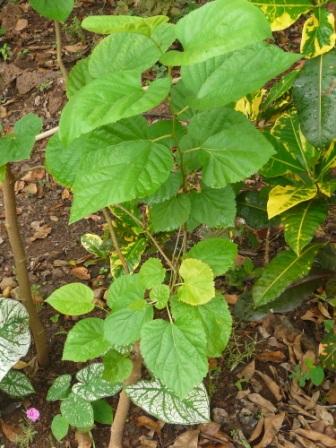
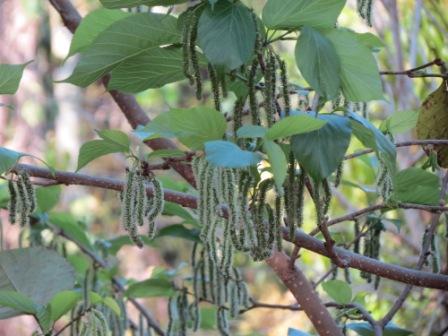
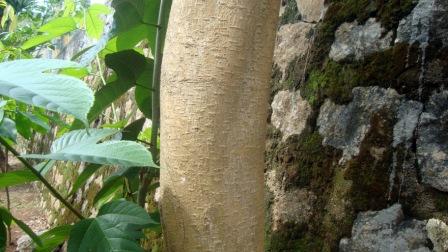
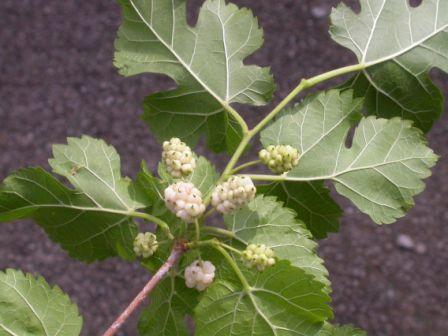
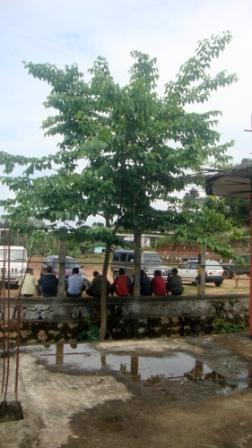
• It is a fast-growing shrub or moderate-sized tree• Bark dark greyish-brown.• Leaves broad dark green in color.• Flowers whitish pink in color.
• Ripped fruits are collected during June-August. • Fruits are depulped and dried in sun.• Seed rate400000 - 450000 / Kg.• Seeds lose viability on storage. • Germination capacity 8 – 10 % only.
Soaking in cold water mixed with camphor for a week.Pre-treatment of cuttings:• Mix one kilogram of Azospirillum culture in 40 liters of water. • Keep the bottom end of the cuttings for 30 minutes in it before planting. • Azospirillum is applied for inducement of early rooting.
Nursery bed preparation:• Select 800 sq.m. area of red loamy soil near water source for raising saplings for planting one hectare of main field.• Apply 1600 kg of Farm Yard Manure (FYM) @ 20 t/ha and mix well with the soil. • Raise nursery beds of 4m x 1.5m size. • The length may be of convenient size depending upon the slope, irrigation source, etc.• Provide a drainage channel and avoid shady area.Pre-treatment of cuttings :• Mix one kilogram of Azospirillum culture in 40 liters of water. • Keep the bottom end of the cuttings for 30 minutes in it before planting. Azospirillum is applied for inducement of early rooting.Nursery planting:• Apply VAM @ 100 g/m2 of nursery area.• Irrigate the nursery bed. Plant the cuttings in the nursery at 15 cm x 7 cm spacing at an angle of 45°. • Ensure exposure of one active bud in each cutting.• The saplings are ready for transplanting in the main field after 90-120 days of planting.
Planting methods:Paired row system:• Plant the cuttings/saplings at a spacing of 75 / 105 cm x 90 cm. Raise intercrops in the wider inter row space (amenable for mechanization also).• Sapcing for Ridges and furrows method – Irrigated : 60 cm x 60 cm or 90 cm x 90 cm. Rainfed : 90 cm x 90 cm.• Pit system: 90 cm x 90 cm.• No. of cuttings / ha. - 27,780 (60 x 60 cm) ; 12,345 (90 x 90 cm)Time of planting• Plant during rainy season• Avoid planting during winter and summer months
Methods of IrrigationRidges and furrows method:• Most efficient method of irrigation• Comparatively requires less amount of water• The furrows serve as drainage channels during heavy rainfall.Flat bed method• Rectangular beds and channels are formed• Water runoff is relatively low• More land is wasted and requires more labour for field preparation.• Most efficient in water use• Substantial saving in irrigation water• Better crop growth• Suitable for undulating terrains• Fertilizers can also be applied along with irrigation water• Clogging of emitters by physical, chemical and biological impurities• Initial cost is very highCultural method• Remove the stubbles and roots of weeds while preparing the land• Use well decomposed manure to avoid dissemination of weeds• Clean the implements before use Mechanical method• Operate country plough after pruning in the interspace• Remove the weeds by hand hoePruning methods i) Bottom pruning :• The plants are cut at ground level leaving 10-15 cm stump above the ground. This type of pruning is done once in a year.ii) Middle pruning • The branches are cut at 40-60 cm above the ground level. After bottom pruning, subsequent cuts are made at 45-50 cm height.
Harvesting Method: • The method of leaf harvest depends on the type of rearing practiced. It is preferable to harvest the leaves during morning hours.• There are three methods of harvesting of mulberry leavesLeaf picking :• Individual leaves are harvested with or without petiole. • Leaf picking starts 10 weeks after bottom pruning and subsequent pickings are done at an interval of 7 - 8 weeks.Branch cutting • The entire branches are cut and fed to the worms. • Before that, topping is done to ensure uniform maturity of the lower leaves. Whole shoot harvest:• The branches are cut at ground level by bottom pruning. • Shoots are harvested at an interval of 10-12 weeks and thus 5 to 6 harvests are made in a year.Time of harvest :• It is preferable to harvest the leaves during morning hours.
• It is a multipurpose tree.• Timber is used by sports industries.• Young leaves are used as fodder for rearing mulberry silk worm and Cattle.• The twigs are used for basket making.
Fibre: Wood yields sulphate pulp with satisfactory strength for white writing and printing paper; bark is worked in to paper pulp and fibre is suitable for the textile industry. Fuel: Makes medium-quality fuelwood with a calorific value of 4370-4770 kcal/kg. Fodder: Leaves are used as fodder for livestock; up to 6 kg of leaves a day can be fed to dairy cows to improve milk yield. Shade-dried leaves incorporated into feed enhance health and egg production in poultry.